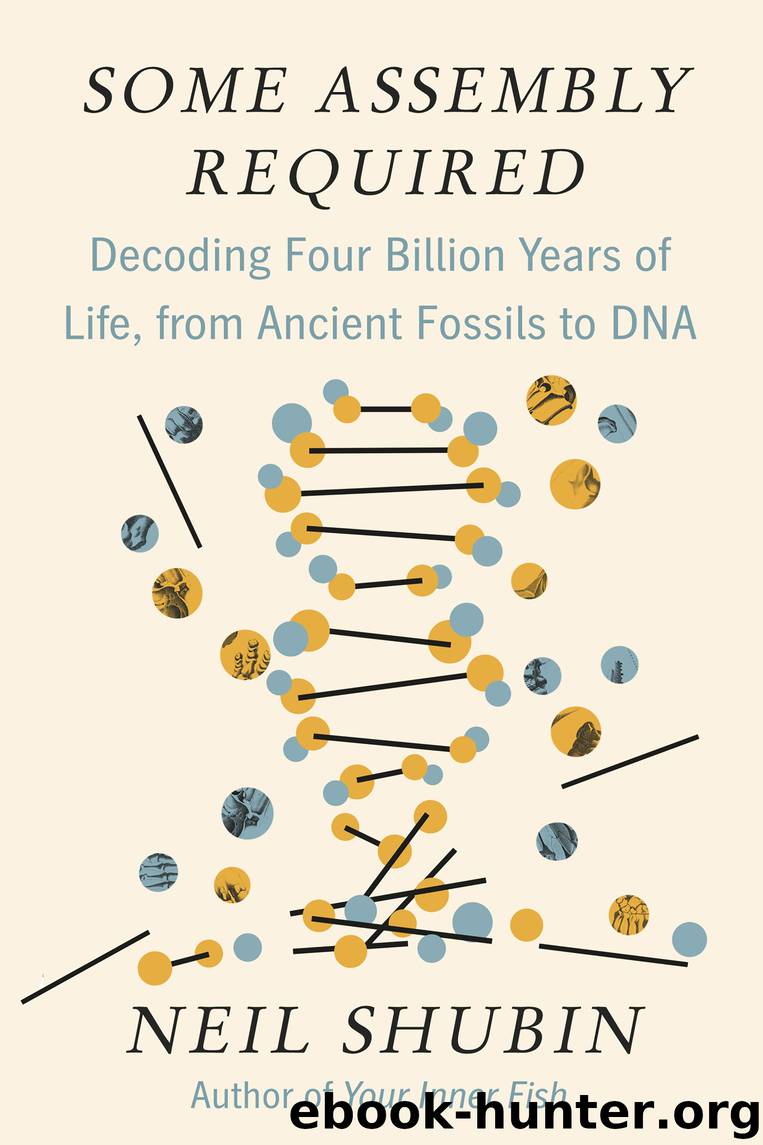Some Assembly Required by Neil Shubin

Author:Neil Shubin
Language: eng
Format: epub
Publisher: Knopf Doubleday Publishing Group
Published: 2020-03-16T16:00:00+00:00
Copies Everywhere
The genome at every level resembles a musical score in which the same musical phrases are repeated in different ways to make vastly different songs. In fact, if nature were a composer, she would be one of the greatest copyright violators in history—everything, from parts of DNA to entire genes and proteins, is a modified copy of something else. Observing duplications in the genome is like wearing a new pair of glasses: the world looks different. Once you see duplications in the genome, you see them everywhere. New genetic material looks like copies of old stuff that was repurposed for new uses. The creative power of evolution is more like a copycat who duplicates and modifies ancient DNA, proteins, and even the blueprints that build organs, for billions of years.
The first people to look at protein sequences, including Zuckerkandl and Pauling, ran right up against duplications. Hemoglobin, the protein that transports oxygen in blood, exists in many forms, each corresponding to a different condition of life. The needs of a fetus differ from those of an adult. In the womb, oxygen comes from the mother’s bloodstream, whereas in adults, lungs are involved. These life stages are marked by different hemoglobins that are copies of each other.
Different amino acid sequences of proteins seemed to be versions of one another. You can find examples in every tissue and organ—skin, blood, eyes, and noses, to name a few.
Keratin is a protein that gives our nails, skin, and hair their special physical properties. Each tissue has a different kind of keratin inside, some pliant, some hard. The keratin gene family formed as a single ancient keratin gene that was duplicated to make keratins dedicated for each tissue.
Color vision happens through the action of proteins called opsins. People see a wide range of colors because we have three opsins, each tuned to a different wavelength of light: red, green, and blue. These opsins have undergone duplications from a single one to the full set of three, with an expansion of visual acuity.
A similar pattern holds for the molecules that aid in smelling. The repertoire of smells that an animal can perceive is in large part defined by the number of olfactory receptor genes it has. Humans have about five hundred of them, but we’re nothing compared to dogs and rats, which have a thousand and fifteen hundred, respectively. (Fish have about 150.) For vision, olfaction, breathing, and virtually everything else animals do, duplicate genes make it all happen. Almost every protein in the body is a modified duplicate of an ancient one, repurposed for new functions.
As Lewis and others who followed him saw, genes that build bodies are often modified copies of one another. Lewis’s genes, Bithorax in flies, and Hox genes in mice are duplicates. Hox genes, so involved with body architecture, are a large gene family that has, over time, only increased in number. Humans, like mice, have thirty-nine, whereas flies have only eight. The same is true for other major toolkit genes that build animal bodies.
Download
This site does not store any files on its server. We only index and link to content provided by other sites. Please contact the content providers to delete copyright contents if any and email us, we'll remove relevant links or contents immediately.
| Cell Biology | Developmental Biology |
| Entomology | Marine Biology |
| Microbiology | Molecular Biology |
| Biostatistics |
Sapiens: A Brief History of Humankind by Yuval Noah Harari(13036)
The Tidewater Tales by John Barth(12026)
Do No Harm Stories of Life, Death and Brain Surgery by Henry Marsh(6332)
Mastermind: How to Think Like Sherlock Holmes by Maria Konnikova(6224)
The Thirst by Nesbo Jo(5778)
Why We Sleep: Unlocking the Power of Sleep and Dreams by Matthew Walker(5636)
Sapiens by Yuval Noah Harari(4528)
Life 3.0: Being Human in the Age of Artificial Intelligence by Tegmark Max(4492)
The Longevity Diet by Valter Longo(4443)
The Rules Do Not Apply by Ariel Levy(3897)
The Immortal Life of Henrietta Lacks by Rebecca Skloot(3820)
The Body: A Guide for Occupants by Bill Bryson(3789)
Why We Sleep by Matthew Walker(3767)
Animal Frequency by Melissa Alvarez(3750)
Yoga Anatomy by Kaminoff Leslie(3696)
Barron's AP Biology by Goldberg M.S. Deborah T(3628)
The Hacking of the American Mind by Robert H. Lustig(3575)
All Creatures Great and Small by James Herriot(3506)
Yoga Anatomy by Leslie Kaminoff & Amy Matthews(3392)
